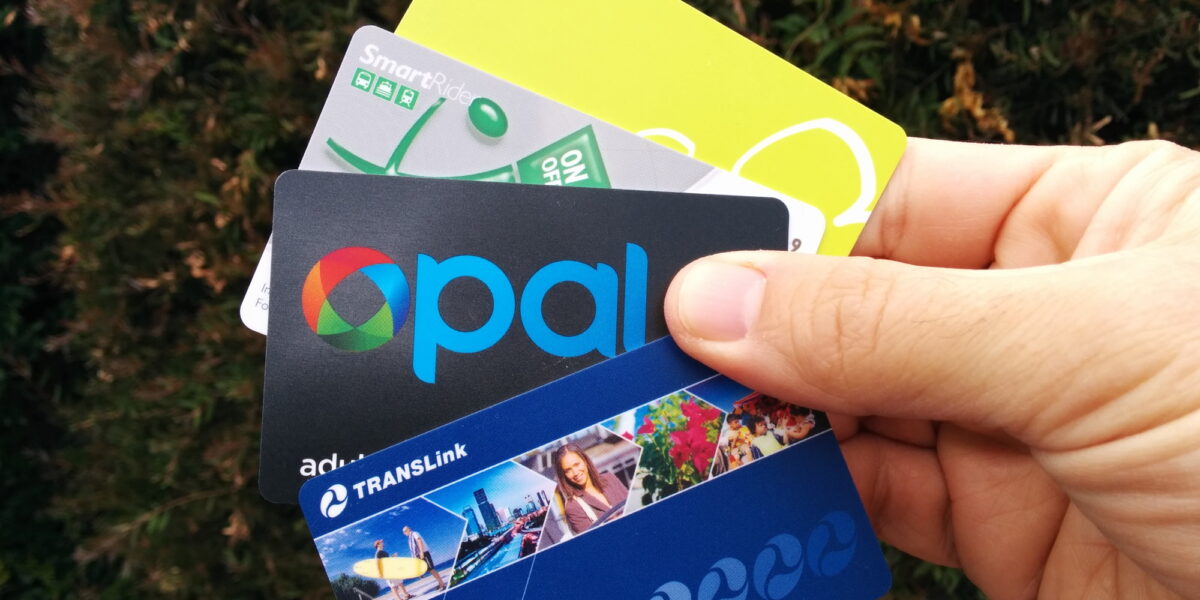Here’s a quick comparison of adult PT fares and discounts in Australian capital cities.
| City | Peak fare | Off-peak fare | Fare cap weekdays | Fare cap weekends | Bulk discount |
|---|---|---|---|---|---|
| Adelaide | $3.95 | $2.20 | $11.00 daily fare (not an automatic cap) | $11.00 | 14 days $63.20 28 days $105.00 |
| Brisbane | $3.37 – $10.17 | 20% discount | No cap | No cap | 8 journeys in one week, then further journeys are half price |
| Canberra | $3.22 | $2.55 | $9.60 | $5.87 | 5% discount if loading card using BPay or auto load. Calendar month cap 40 trips |
| Darwin | $2.00 | Same as peak | No cap[1] | No cap | 7 days $20 |
| Melbourne | $3.10 – $4.60 | Metro trains free before 7:15am A single 2 hour fare applies from 6pm to 3am Otherwise same as peak | $6.20 – $9.20 | $6.20 – $6.70 | 7 days $31 – $46 28 days $104.16 – 154.56 (Any number 28-365 days available) |
| Perth | $1.98 – $4.41 | Same as peak | $9.80 | $9.80 | 11% discount if using auto load[2] |
| Sydney | $3.20 – $8.99 | 30% discount | $16.30 | $8.15 | Weekly cap $50 |
Footnotes:
- This is looking only at adult fares using a smartcard. Cash fares/paper tickets, where offered, are more expensive.
- [1] At least, the web site doesn’t mention a fare cap for Tap And Ride card users. You can buy a $7 cash daily ticket.
- [2] Smartrider is a 10% discount from a cash fare. Auto load Smartrider is a further 10%. This means Smartrider manual load vs Auto load is an 11% discount.
The base fare varies by the distance or number of zones. Adelaide, Canberra and Darwin have a single zone. Melbourne has two zones. Perth has more but fares are capped at two zones. Sydney and Brisbane have more zones.
Most cities offer an off-peak discount, but some don’t, and in Melbourne the discounts are somewhat extreme, and inherited from earlier ticket systems.
Melbourne’s daily fare cap is smart, in that it takes into account the zone/s you’ve used. The others are such that you may not reach the cap if taking a lot of short trips, but you probably will if taking two long trips.
Ditto Sydney’s weekly cap, which if you’re an everyday long distance commuter, you’ll hit pretty quickly. Adelaide, Darwin and Melbourne make you pre-load a weekly fare to get the discount. Canberra and Perth instead give you a discount for setting your smartcard to auto load.
(Thanks Alex, who pointed out that Adelaide’s daily fare is not a cap; you need to buy it in advance)
Which fare system is perfect? None of them really, they all have their pros and cons.
Finding the right mix to encourage people to use the system, while still raising good levels of revenue to help fund services, is a balancing act. I’d love to see some changes for Melbourne (and even moreso for V/Line fares, which have a number of anomalies), but given much of our fare system dates back to the 1980s, I’m not holding my breath.
- I originally started looking at this in case there was something revolutionary that I should mention for for this story earlier in the week.
- This post compares fares. See also: a 2014 blog post comparing ticketing systems.


5 replies on “Comparing fares”
To be absolutely completist, Canberra’s bulk discount also includes a 40 trip cap in any calendar month. So a maximum of $128.80/month, but less if there are a few off-peak and weekend fares in the mix.
Adelaide, doesn’t really have a fare cap. You need to buy a paper “day trip” ticket before you travel and use that instead of a Metro card. Gives free travel for children in school holidays and weekends included in your ticket. So if you do two peak trips and two interpeak, you should have used a day trip, but it’s too late now.
Thanks both, will update the table!
Any other corrections very welcome!
When I lived in Queensland, their fares seemed more expensive, but travelling from GC to Brisbane was like 80km! So I think the $$ per km travelled ended up being slightly cheaper.
Their trains (at least the ones I took) were much nicer than the ones I took in Melbourne. They were much more reliable, though less frequent. Whenever their trains stuffed up, they were much slower at setting up replacement buses than Melbourne – probably because Melbourne is so used to having failures haha.
Sydney’s cap is more than the cap of any other system that has a cap, but it applies throughout the Opal system, so end to end travel is considerably value for money.